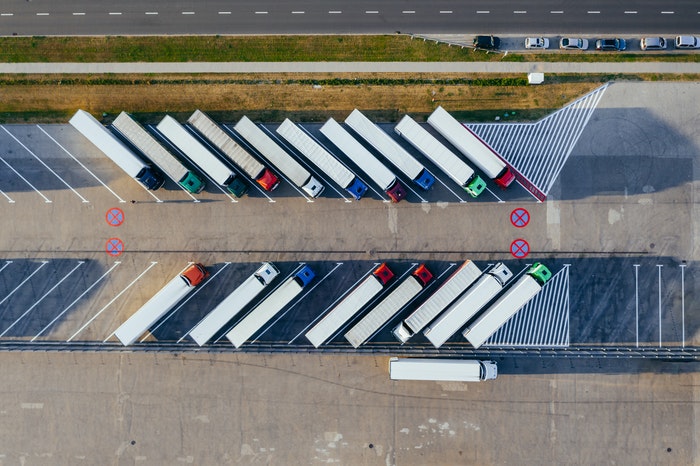Fleet tracking technology has helped the trucking industry in a number of ways, from improved safety and efficiency to cost savings and productivity. By enabling business owners and fleet managers to monitor and manage their vehicles, fleet tracking technology has made it easier to track trucks, identify improvement areas, reduce fuel costs and improve fleet performance. Read on to learn more about how fleet tracking technology has helped the trucking industry.
Fleet tracking technology helps improve safety by providing detailed location and speed information so drivers can be monitored in real time. This allows businesses to stay updated on location information and identify unsafe driving habits such as speeding or hard braking. Additionally, with detailed reports about driving behaviors such as excessive idle time, dispatchers can ensure that all vehicles operate safely and efficiently.
Not only does fleet tracking technology give businesses insights into driver behavior behind the wheel, but it also helps with productivity management in other ways. Automatic reporting capabilities generate data for efficient route optimization and help create a paperless work environment by eliminating manual paperwork requirements for drivers throughout the trip. Further still, GPS navigation capabilities help dispatchers accurately plan routes from start to finish to ensure timely deliveries with less downtime spent idling at unplanned stops or taking wrong turns due to poor routing decisions.
Overall, with an improved understanding of each vehicle’s behavior on the road combined with real-time data regarding location history and performance indicators (e.g., idle time), businesses have been able to benefit from reductions in both fuel costs and labor costs due to higher levels of efficiency across their fleets thanks to effective deployment of fleet tracking technology solutions.
Benefits of Fleet Tracking Technology
Fleet tracking technology has revolutionized the trucking industry over the past few years. It has enabled trucking businesses to gain real-time insights into their fleet performance and operations. This has resulted in streamlined processes, improved customer service and increased profitability. Let’s delve into the various benefits fleet tracking technology offers the trucking industry.
Improved Safety
Fleet tracking technology has significantly improved safety within the trucking industry due to its comprehensive functionality. This form of data-driven technology can track vehicles, alert drivers in areas with hazardous climates or road conditions, and monitor driver behavior.
The most advanced fleets take advantage of GPS-based tracking systems to ensure drivers follow safe and cost-effective routes. It also allows for real-time awareness about the location of drivers and their vehicles. Sensors placed on trucks can alert drivers to changes in tire pressure, engine temperature, and other important metrics, helping them abide by the industry’s safety regulations.
By using vehicle installation data such as accident reports, real-time mapping systems allow dispatchers to monitor risky sections of roads with potential hazards like sharp curves or pre-accident conditions like wet or icy surfaces. Integrating the software into a fleet tracking system also assists managers in keeping informed on current DOT standards and industry regulations related to safe hours and route assignments while monitoring idling times throughout shifts.
By utilizing telematic information such as GPS location data combined with driver metrics, including braking patterns, an analytics system can accurately detect aggressive driving habits, which can then be rectified through coaching programs that are tailored specifically for each driver based on their abilities and preferences. Overall, fleet tracking technology has improved safety within the trucking industry by offering operators a range of benefits that greatly enhance efficiency while driving down overhead costs associated with poor decisions in terms of safety compliance requirements.
Increased Efficiency
Fleet tracking technology is one of the most important trends in the trucking industry; it provides up-to-date data about fleet performance and increases efficiency. Using GPS technology, motor carriers can track the exact location of their trucks and cargo, store vehicle information, set routes for driver compliance, and more. Additionally, fleet tracking technology can detect traffic delays, poor driving behavior, and excessive idling. This increased visibility into the trucking operations enhances safety on roadways and helps drivers stay compliant with government regulations.
The trucking industry continues to reap numerous benefits from utilizing fleet tracking technology. With real-time notifications about the fuel consumption, motor carriers are able to reduce fuel costs by keeping fuel usage under control. Accurate ETA times allow for better customer service, with deliveries arriving on time or earlier than expected. Driver compliance with regulations allows carriers to avoid fines and penalties that result in decreased revenue. Fleet tracking also significantly reduces dispatch time by improving productivity and eliminating manual paperwork. The reduced freight cycle times decrease operating costs while allowing businesses to meet customer demands faster, resulting in an overall increase in profitability.
Reduced Costs
Fleet tracking technology helps in reducing the costs associated with the trucking industry. This can be done in several ways, including using GPS-based systems for route optimization and telematics-based systems for preventative maintenance and other cost savings measures.
Route optimization software uses GPS data to calculate the most efficient routes from any given point A to B, helping to reduce fuel costs and, in some cases, even time spent on the road. By having accurate forecasts that take into account traffic delays or closures, fuel consumption can be reduced dramatically.
Meanwhile, telematics-based systems provide real-time data about a vehicle’s systems, including engine performance and maintenance needs. Thanks to this data, companies are better able to monitor vehicle health and anticipate any maintenance needs before they become an issue. This helps to avoid unnecessary downtime and keep costs down since expensive repairs can be avoided by taking care of issues at their earliest signs of trouble.
With fleet tracking technology capable of monitoring every aspect of a truck’s performance while it’s on the road, companies are able to reduce operational costs through greater efficiency with reduced manual labor requirements. By gaining a better understanding of how vehicles behave under different conditions (such as weather during different times of day or night), companies can gain insight into better methods that make sure action is taken only when necessary while also streamlining processes that would have previously required manual efforts from staff members.
Improved Customer Service
Using fleet tracking technology helps trucking companies improve customer service. Companies can provide customers with accurate arrival and delivery times, get real-time updates on the status of their shipments and make fast decisions in case of delays. For example, a truck may run into a mechanical issue during its travel. However, the company can quickly reroute it to a nearby location for repairs and still keep its customer informed.
This level of service also allows transportation companies to gain customer feedback about their experience. The tracking system collects data on views such as estimated arrival time that can be used to pinpoint any discrepancies or areas for improvement in customer satisfaction. Companies will then be able to adjust and revise their processes accordingly, improving quality control and efficiency. Moreover, better customer service can lead to higher ratings and enhanced reputation overall.

How Fleet Tracking Technology Works
Fleet tracking technology has revolutionized the trucking industry by providing owners, operators, and drivers with real-time data and insights on vehicle location, driver behavior, safety, and more. This technology comprises onboard devices and GPS that can monitor and track vehicles and their drivers, giving companies a better understanding of their operations and an improved ability to manage their fleets. Let’s take a closer look at how fleet tracking technology works.
GPS Tracking
GPS tracking is one of the most important components of fleet tracking technology. The GPS satellites, created and maintained by the U.S. Department of Defense, constantly broadcast signals that can be used to determine a position anywhere on the planet. Fleet tracking systems use these signals to locate each vehicle in the system and track its movements.
The pinpoint accuracy of global positioning satellite (GPS) systems allows them to detect specific locations within yards or even feet — far better than other navigation systems available today. GPS data is usually relayed in two ways: via a basic text-based transmission containing latitude and longitude information; or an Enhanced Data Transmission containing more elaborate information like driver identification, speed, and direction.
GPS loggers are often attached to vehicles for continuous monitoring, meaning real-time updates on each vehicle’s location and travel times are available 24/7. This is particularly useful for fleet logistics companies with multiple vehicles who must stay on top of their arrival times at final destinations as accurately as possible.
Advanced fleet tracking technology can also offer additional features such as geo-fencing, which allows virtual geographic boundaries to be set up around designated areas and triggers notifications when a vehicle moves outside these boundaries; fleet management tools that permit remote control over multiple vehicles; email alerts based on speeds, directions, stops and driver behavior; route optimization for fuel consumption optimization; logbook management software for digital “driver” record keeping; smartphone apps transfers fleets into virtual worksites, enabling easier communication with drivers from any location at all times; automated vehicle maintenance schedules to alert managers when it’s time for services or repairs on their vehicles; customizable reports that can help uncover relationships between changes in driver behaviors & patterns with fuel efficiency & mileage performance. All these features make GPS-enabled fleet tracking much more efficient than other conventional platform approaches for managing mobile assets & workforces.
Telematics
Telematics is a branch of technology that combines telecommunications and informatics, or information technology. In the context of fleet tracking, telematics collects data from trucks and other vehicles using GPS (Global Positioning System) technology, then transmits that information back to the office or dispatch center. This allows fleet managers to accurately track their vehicles’ location and status in real time.
Telematics also includes more than just GPS tracking alone; this system has multiple sensors inside each vehicle that track vehicle performance and driver behaviors. Data such as fuel efficiency, speed, engine idle time, aggressive driving behaviors, air pressure in tires, load capacity, and more can be monitored to ensure optimal performance and safety across your entire fleet. By collecting this data in real time, managers can make informed decisions about their operations that can help save money on labor costs and fuel expenses.
In addition to monitoring basic operation metrics, telematics can also provide analytics such as route/task optimization to improve profits by reducing outbound delivery times and enabling better tracking of schedules/tasks so shipments get delivered on time with no accountability gaps or delays due to last-minute changes. This advanced data is all displayed in an easy-to-understand dashboard, along with instant notifications when something within the fleet doesn’t meet standards set by the company itself. The extensive benefits of telematics are why it has become an industry standard within trucking fleets across all levels, including local small businesses up to huge global corporations.
Automated Logging
Fleet tracking technology has revolutionized the trucking industry. Automated logging with telematics is companies’ most common type of fleet tracking software. This technology provides insights into driver habits, vehicle performance, and more. It improves safety by recording and storing driver activity, ensuring they comply with hours of service regulations.
Automated logging systems allow trucking companies to see where their drivers are and what they do while in transit. These systems utilize GPS to track routes, locations, stops, start times, end times, idle time, speed limits, and more. It also helps ensure that trucks are not overloaded or driven too long without a break. For example, suppose the loaded weight exceeds federal guidelines. In that case, trucks will be flagged automatically at weigh stations via automated onboard system scanners linked to the GPS device in the vehicle’s logging device.
By using reliable hardware components such as sensors and an assortment of telematics software solutions that can be integrated into a trucking company’s existing IT infrastructure, automation becomes possible. With data collected from participating vehicles, an automated reporting system can be set up so that reports about individual drivers or whole fleets can easily be accessed for analysis purposes or for customer service assistance when required. The collected data can also be used in determining road safety concerns within specific areas or through providing assistance with backup vehicle dispatch solutions when necessary, helping reduce time lost due to accident response or breakdowns along a planned route, quickly identifying any related issues allowing them to be addressed in a timely manner before a substantial loss occurs as a result of delayed deliveries.

How Fleet Tracking Technology Has Helped the Trucking Industry
The trucking industry has seen a significant boost in performance and efficiency thanks to the introduction of fleet tracking technology. This technology has revolutionized the industry by allowing operators to monitor the performance of their vehicles, track inventory, and optimize routes. It has also improved safety, increased cost-effectiveness, and reduced driver fatigue. Let’s take a look at what fleet tracking technology can do for the trucking industry.
Improved Safety
Fleet tracking technology has revolutionized the trucking industry. In addition to providing effective cost-saving strategies and competitive insights, fleet tracking has also improved safety standards for commercial truck drivers.
Fleet technology helps diminish the dangers of accidents due to driver fatigue or error by monitoring a driver’s overall behavior. Some systems use sensors to detect and monitor a driver’s current state and alert them when they need a break or are in danger of an accident. The data collected by these systems can be used to develop driver safety profiles over time, allowing critical trends or issues with drivers to be identified quickly, reducing risks, and improving safety performance across an entire fleet of trucks.
Fleet tracking technology also provides real-time insights into hazardous weather conditions or other known dangers on the road. Incidents can be mapped out ahead of time, making it easier for management teams to plan routes and adjust schedules accordingly, ensuring their drivers’ safety while on job duties. By proactively monitoring traffic patterns, speed limits, route selection accuracy, and other critical information, potential collisions caused by poor route selection are dramatically reduced.
Overall, fleet tracking technology helps improve safety measures by monitoring a driver’s overall performance and providing route optimization suggestions that address changing conditions on the road quickly and accurately. Such proactive measures help ensure safe driving conditions for all involved parties wherever commercial vehicles may roam.
Increased Efficiency
Fleet tracking technology has allowed the trucking industry to become more efficient. This type of technology helps to monitor and track all vehicles within a fleet and can provide a variety of types of data, such as vehicle location and driver behavior. This means dispatchers can better organize their workforce, identify optimized routes, and reduce fuel consumption.
Fleet tracking technology has contributed to increased efficiency by reducing the paperwork involved with tracking vehicles, goods, and services. By automating the process, businesses can better allocate resources according to demand and more accurately predict future trends. This type of optimization allows businesses to operate more efficiently, saves them money in the long run, and increases overall customer satisfaction levels via an improved performance from their infrastructure systems.
The GPS capability in these systems also allows for real-time updates on drivers’ locations so that businesses are able to respond quickly when customers require their services urgently; this feature also allows for planned delays or pickup changes as needed with much less stress or effort applied by workers. With fleet management software, managers can be informed immediately should maintenance or repairs be necessary, ensuring that vehicles remain on the road safely while minimizing any potential production risks associated with unexpected machine failure or inspection-related events. Finally, better route planning capabilities improve delivery time accuracy while reducing wasted energy due to undirected driving patterns.
Cost Savings
The use of fleet tracking technology provides numerous cost savings opportunities for the trucking industry. With Fleet tracking technology, companies can maximize their vehicle’s fuel efficiency, reduce the need for unnecessary maintenance and repairs and accurately track driver performance.
Fuel savings can be achieved through more efficient routing and dispatching options that are available through fleet tracking software. By reducing fuel costs, companies can save money in various ways. Furthermore, real-time mileage measurement can be used to accurately assess driver performance and promote higher degrees of efficiency from their drivers. This information is also beneficial when analyzing vehicle service histories to identify areas where repairs can be made sooner or avoided entirely for extended durations of time.
In addition to reduced operational costs, fleet tracking technology permits the accurate tracking of driver timesheets for payment records or for meeting delivery deadlines. With shared data about a vehicle’s location, delivery schedules can be managed more efficiently, helping companies uphold their commitments to customers without any interruption in service quality or cost issues along the way.
By implementing fleet tracking technology into operations, trucking businesses are able to significantly reduce operational expenses while improving customer experience with better responsiveness and services at reduced rates.
Improved Customer Service
Fleet tracking technology is driving change and improving the customer experience in the trucking industry. By integrating tracking data with transportation management systems (TMS), transportation companies can gain valuable insights into the current state of their operations, creating better communication between all involved parties. This means they can provide better services to their customers by creating a real-time picture of the products they are transporting.
Fleet tracking technology enables customers to access shipment information quickly and easily, resulting in improved communication with shippers. Through this technology, customers receive timely updates about their shipments, allowing them greater peace of mind, and eliminating questions about expected delivery times and other shipment details. The ability to provide detailed reports and timelines lets customers know when their shipments arrive or depart from a certain location, enabling them to make informed decisions about their supply chain needs.
Not only does fleet tracking keep customers up-to-date with shipment information, but it also aids fleet owners and managers in optimizing routes for cost savings from fuel costs and improved utilization of assets. Improved access to data through this technology allows dispatchers to quickly create a plan based on current conditions that take into account traffic restrictions or road closures due to construction or maintenance projects.
Overall, fleet tracking has enabled increased efficiency among shippers while improving customer service and satisfaction levels at the same time. This level of innovation has helped transform the trucking industry for all parties involved — from shippers and carriers down to end-customers who are able to quickly access more detailed information regarding deliveries worldwide.
Conclusion
Fleet tracking technology has provided numerous cost-saving and efficiency gains to the trucking industry. Benefits include improved employee visibility, driver safety, and optimized route planning. Additionally, better driver coordination leads to faster response times, increased productivity, decreased fuel consumption, and lower maintenance costs. Trucking operators can maximize the efficiency of their fleet’s operations and profitability by leveraging the power of GPS tracking data in combination with sophisticated analytics tools like artificial intelligence or machine learning algorithms.
Fleet tracking technology is truly transforming the industry in many positive ways, and modern fleets are now operating more efficiently than ever before. With real-time data at their fingertips, trucking operators armed with the right information can confidently make informed decisions that ultimately lead to higher profits for their businesses.
Find a Home-Based Business to Start-Up >>> Hundreds of Business Listings.

















































